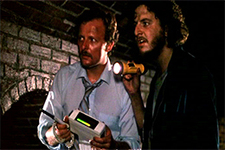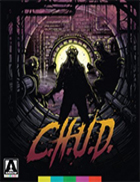C.H.U.D.
|  In one of the more amusing entries in his book The New York Grimpendium: A Guide to Macabre and Ghastly Sites in New York State, J.W. Ocker imagines the pitch meeting for C.H.U.D., in which a roomful of moneymen immediately agree to fund the movie based on the title alone. “And seriously,” Ocker writes, “what even apathetic movie watcher isn’t going to pay attention to a movie with a title like C.H.U.D., much less the dedicated horror movie fan. How can anybody resist the urge to reference the title at random but regularly occurring occasions, further perpetuating its legacy? Who cares about the movie itself? The title is reward.” And a great title it is: An acronym for “Cannibalistic Humanoid Underground Dwellers” (although it is later revealed to have a second meaning that is purposefully obscured by the whole cannibal thing), it exits your mouth with delightfully blunt force—chud!. And while the movie doesn’t quite live up to that title, it is still a fun slice of Reagan-era monster madness that embodies more than a few of its era’s political and environmental fears. C.H.U.D. is first and foremost an urban horror movie—a kind of B-movie creature-feature variation on Taxi Driver’s portrait of New York inner-city hell, except rather than just insidious steam belching from the manholes in the wet pavement, we get mutated humanoids looking to feed on the city’s denizens. That is precisely what happens in the film’s opening moments, as a woman walking her dog down the street alone at night is dragged screaming beneath the city street, one of her shoes left behind to be swept away the next morning by the street sweeper. The woman turns out to be the wife of Captain Bosch (Christopher Curry), a homicide investigator who becomes determined to find out what happened to her, even though his superiors keep warning him not to dig too deep (always the sign of a nefarious cover-up). His investigation brings him together with two other men who are following similar trails: George Cooper (John Heard), a photographer whose model girlfriend (Kim Greist) wants him to do fashion shoots, but who wants to do serious photojournalism about New York’s homeless population, and A.J. “Reverend” Shepherd (Daniel Stern), a frazzle-haired hippie who runs a soup kitchen and has noticed that his regulars have been disappearing over the past several weeks amid rumors of monsters in the sewers. The idea of monsters dwelling in the dark, nasty spaces beneath our cities is nothing new. In the 1800s there were stories about ferocious black pigs breeding in London’s sewers, and accounts of alligators living in the sewers beneath Manhattan date back to the 1920s, an urban legend that was given vivid literary treatment by Thomas Pynchon in his 1963 novel V. It isn’t much of a stretch to imagine the subterranean world of sewer, subway, and access tunnels being home to all manner of terrible things, and C.H.U.D. merges that sense of urban-legend fearmongering with then-topical concerns about toxic and radioactive waste—the noxious, lethal byproduct of the atomic age and the nuclear arms race that, as the movie would have it, is responsible for turning the city’s underground homeless population into massive humanoid killers with glowing eyes and bulging necks. It’s a great B-movie premise, and director Douglas Cheek, a documentary editor making his lone appearance in the director’s chair, gives it a solid go, merging horror conventions with the kind of political paranoia that fueled movies like The Parallax View (1974) a decade earlier. The film’s villain is really Wilson (George Martin), a corrupt bureaucrat for the Nuclear Regulatory Commission whose despicable dumping of toxic waste in the sewer system is the root of the problem. The C.H.U.D.s are, if anything, victims, albeit ones with mouths full of sharp teeth, handfuls of claws, and a nasty disposition that causes them to make short work of anyone who comes within their reach (including various government workers, whose neon-yellow-clad remains are scattered all over the sewers, and a pair of cops played by then-unknown John Goodman and Jay Thomas). C.H.U.D. was a minor theatrical hit and took on a life of its own on video, where its ubiquitous presence in early video stores and on cable television turned it into a beloved cult favorite among low-grade horror enthusiasts. Interestingly, though, virtually no one behind the camera went on to do anything else. Cheek, whose work as director is better than you might expect, went back to editing documentaries, including Outfoxed: Rupert Murdoch’s War on Journalism (2004), Wal-Mart: The High Cost of Low Prices (2005), and the PBS production Empires: Peter & Paul and the Christian Revolution (2003), which he also co-directed. Similarly, neither screenwriter Parnell Hall nor Shepard Abbott, who got story credit, ever penned another script (Hall turned to writing mystery novels). There is some controversy about the script, as actors Daniel Stern and Christopher Curry claim to have extensively rewritten it themselves, much to the consternation of producer Andrew Bonime, who worked for half a decade to get the film made, but never produced anything else (he has since gone into eBusiness and penned the textbook Writing for New Media). The film did help launch a few bourgeoning careers, including editor Claire Simpson, who went on to edit several of Oliver Stone’s films (including 1986’s Platoon, for which she won an Oscar) and British composer David A. Hughes, whose bombastic electronic work here led to a lengthy career scoring mostly independent films (including Guy Ritchie’s 1998 debut, Lock, Stock, & Two Smoking Barrels). Makeup designer John Caglione Jr., a protégé of Dick Smith and Tom Savini, has gone on to an extensive career in makeup effects work, winning an Oscar for Dick Tracy (1990), and the film was also an early success for casting legend Bonnie Timmerman, whose career was just beginning to take off. Of course, in front of the camera Timmerman managed to land John Heard and Daniel Stern, both of whom were near the beginnings of the careers, but had already appeared in several well-known films; Heard had had starring roles in Cutter’s Way(1981) and Cat People (1982), and Stern had memorable supporting roles in Breaking Away (1979) and Diner (1982). Their respective performances certainly elevate the film (similar productions often run aground on amateurish theatrics), and while no one will ever mistake C.H.U.D. for a work of cinematic genius, it is a fun eco-horror diversion whose patience, political themes, and willingness to play out a mystery rather than just head straight for the throat (which it does eventually) makes it more than just a rote exercise in underground monster mayhem.
Copyright © 2016 James Kendrick Thoughts? E-mail James Kendrick All images copyright © Arrow Video | |||||||||||||||||||||||||||||||||||
Overall Rating: 

 (3)
(3)


